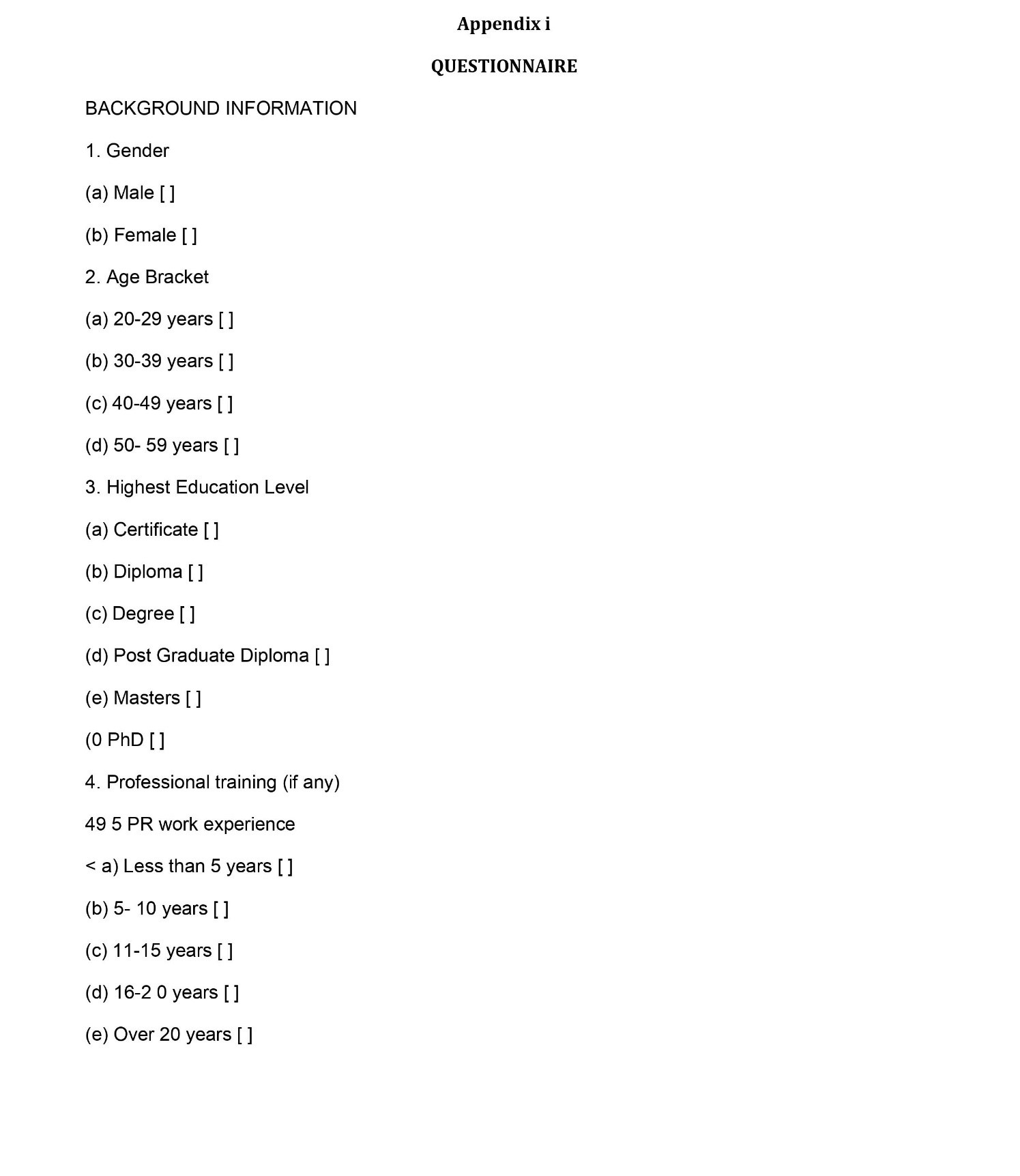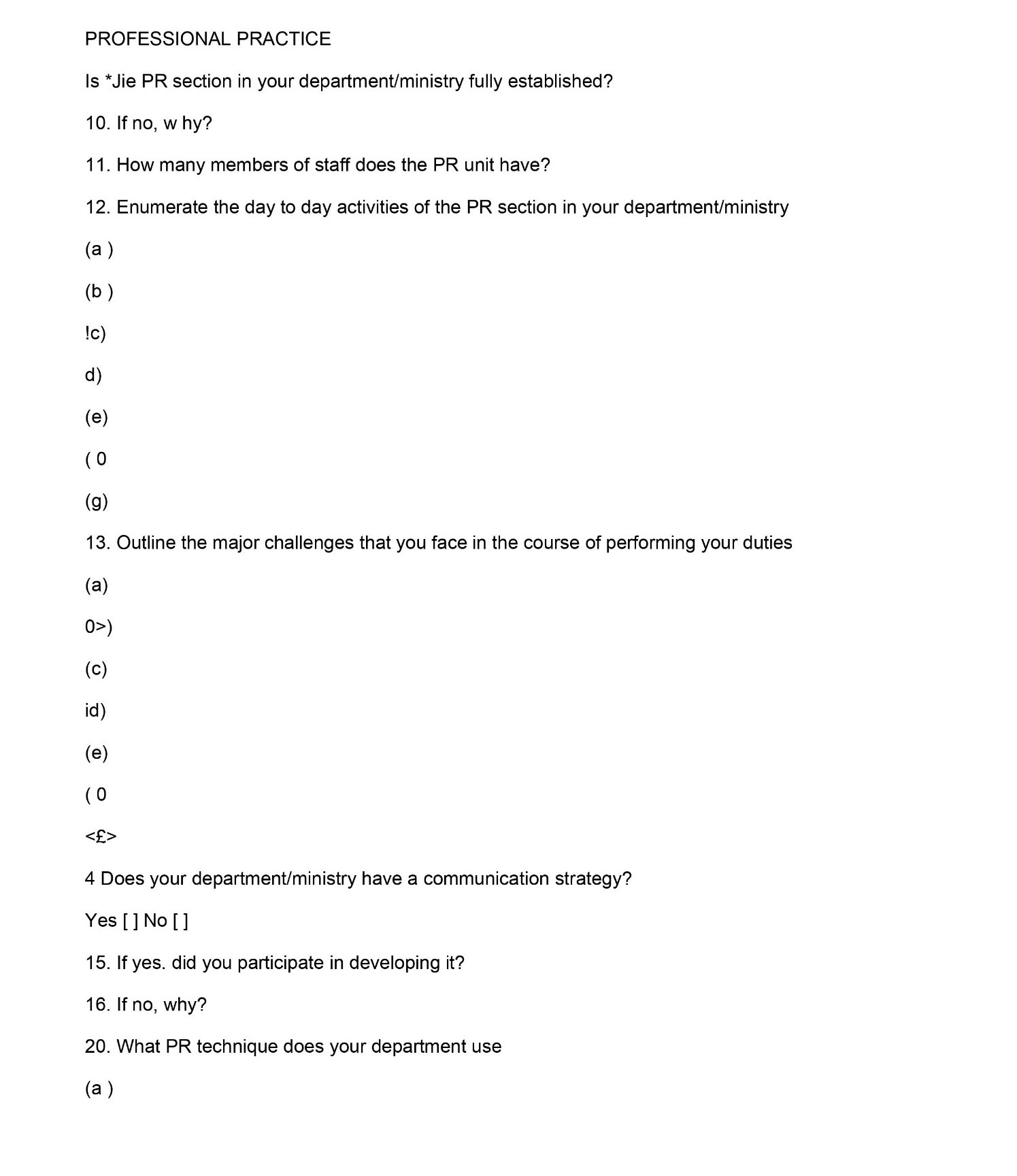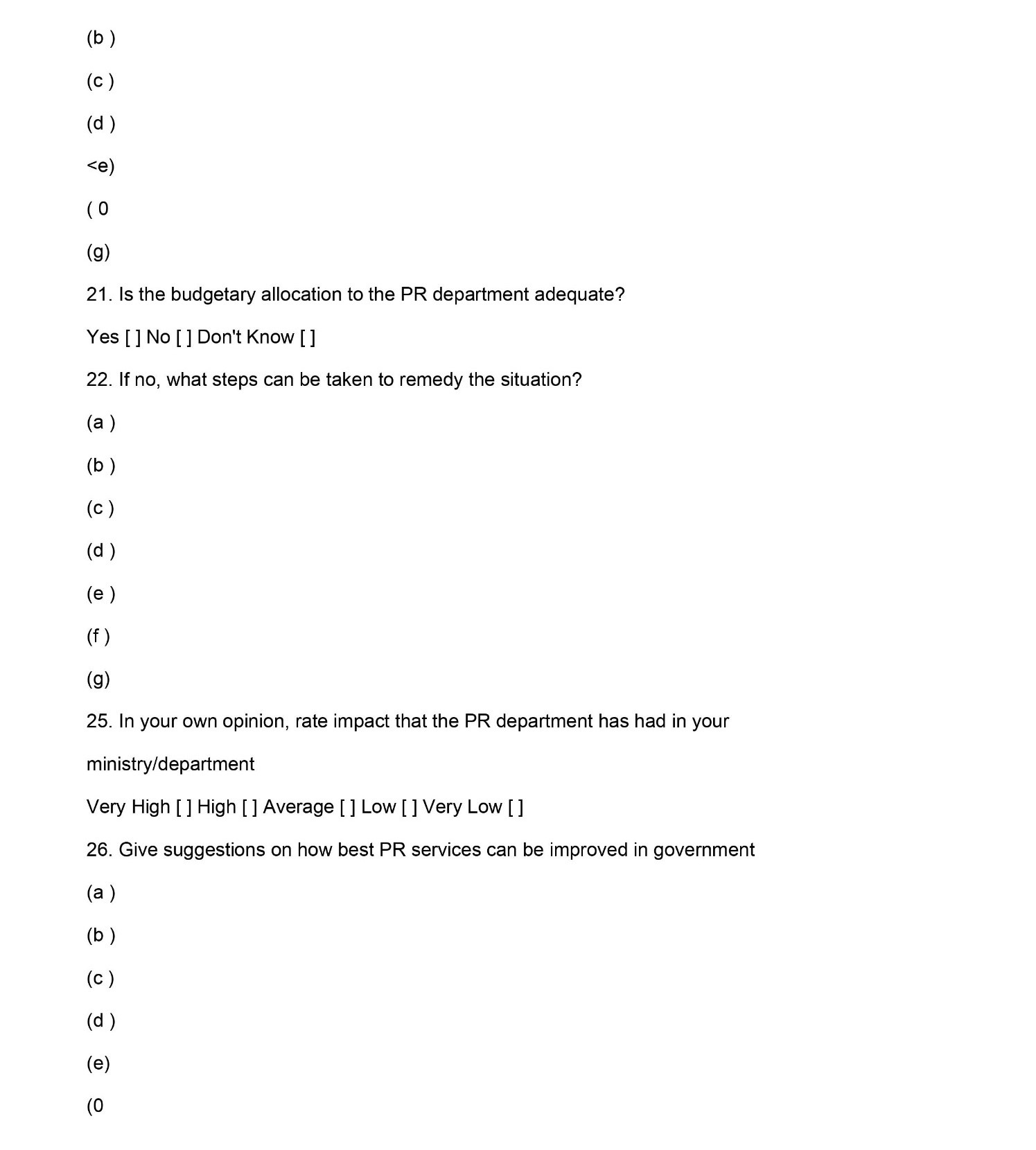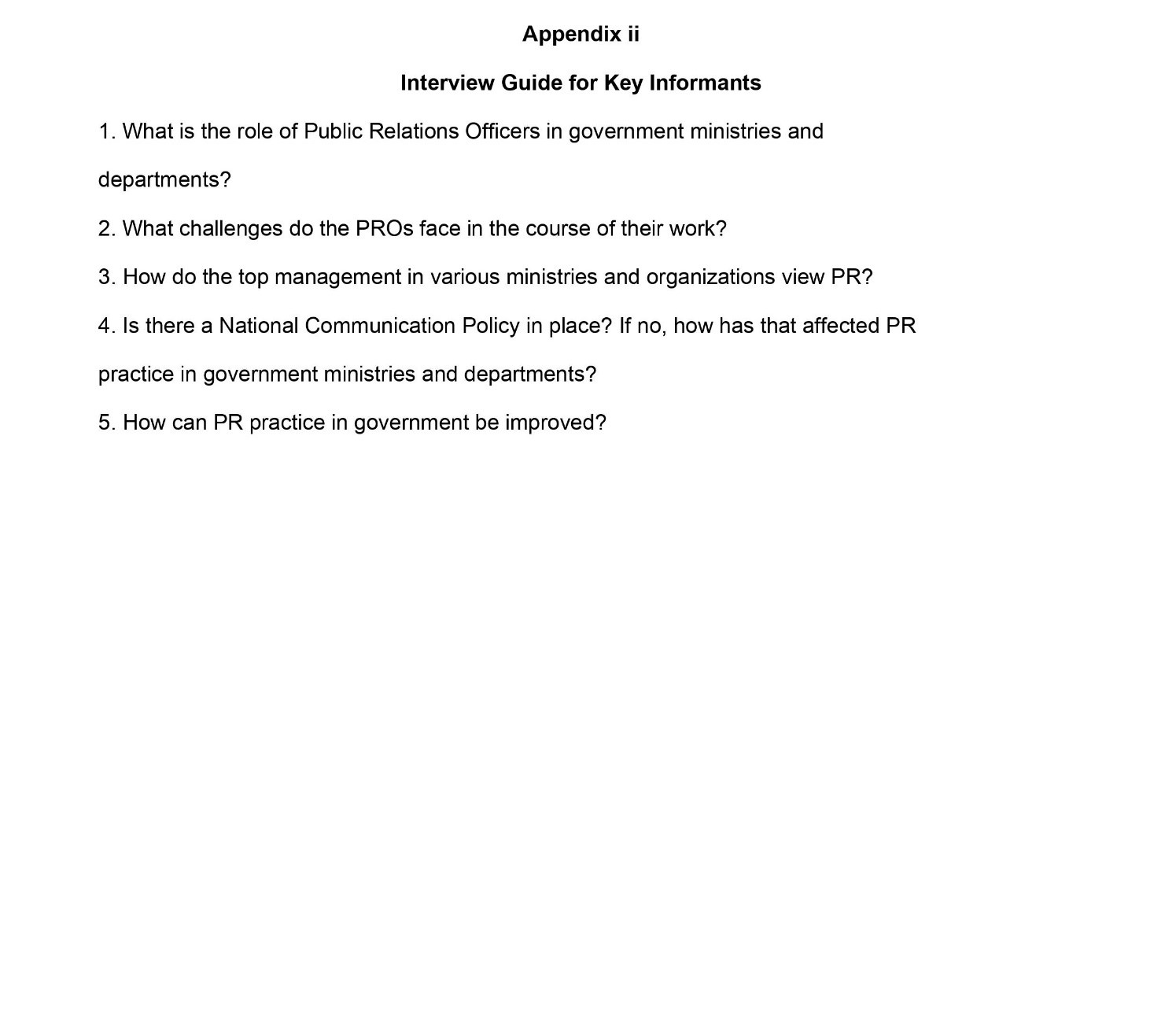Public Relations in practice, Political Public Relations
Public relations practice (PPR) is widely recognized as an important part of the contemporary world and has contributed to various sectors such as corporations, governmental agencies, and non-governmental agencies. In the contemporary world, all political organizations display a dire need to connect with the public to have a stronger ground root and execute their agendas and manifestos. Discussions of the role or performance, or PPR within the context of political affairs emphasize two distinct areas, the adoption of public relations practices by the non-governmental activists and the use of these practices by the government in political processes. This dissertation will discuss the practice of PR in liberal democratic societies with an emphasis on corporate public relations. Moreover, it focuses on analyzing the role of public relations in the various ministries of the government since the practice of PR creates a positive image of the state government and reveals the government's policies and development agendas to its citizens.
1. INTRODUCTION
1. Theoretical Background
Public relations (PR) is described as an organized effort to establish goodwill and a mutual apprehension, which builds a strong relationship between an organization, corporation, and the government and their publics. PPR allow political protagonists to create good reputations and relations with the targeted audience through effective communication activities and strategies to gain political goals and ensure support from the public (Kantola, 2016). A similar conclusion was made by Johnston & Sheehan (2020) who stated that the goal of public persuasion is achieved successfully through the use of various communication mixtures. However, Béland (2017) had earlier indicated that conflicts of interest can have a negative impact on the ability of PR practitioners to share credible and reliable information to the public, particularly during election campaigning. Therefore, Kantola (2016); Johnston & Sheehan (2020) agree that modern political actors use are a variety of media sources to access insights associated with public opinion which can inform about current political events. Consequently, conscientiously planned programs that prioritize the interests of the public are needed that consider major factors in politics including public opinions and semantics, media reach, policy selection, and prioritization of public interests.
Studies Tedesco (2011); Kiousis and Strömbäck (2014) have acknowledged that the two major benefits of PPR are to minimize political crisis and enable a candidate to gain much-needed exposure. On the other hand, the findings of Sanders (2019) revealed that PR should focus on engagement and offers a long-term and strategic perspective in politics especially for government activities and specialists in political communication. Therefore, it implies that PR professionals are obliged to create awareness of various government policies that affect the public
Modern governments have used the concept of public relations to implement their policies and monitor its performance of the practice (Kiousis & Stromback, 2011). PR professionals face challenges associated with the efforts to limit media access and maintain mutual relationships with journalists. In some nations or rather societies, the antagonistic relationship between the government and the media, especially news coverage media, represents a critical element of a functional democracy (Lieber & Golan, 2011). However, in line with the ideas of Béland (2017), it can be concluded that the key areas that are commonly evaluated include internal communication organizations, image management, information management and media management.
2. Research problem
The diversity of activities and goals within the government are wide and are diverse than any other section of public relations. The foundation of every democratic society is based on the public getting information regarding the government structures and needs of society that need to be incorporated in the policies made (Somerville & Ramsey, 2013). Krishna, Connaughton and Linabary, (2020) state that political actors focus on persuading individuals through a one-way and manipulative communication process based on political contents and ideas.
The major issue associated with the role of PR in politics includes the ability to develop a more participatory, transparent and accessible public atmosphere (Ihlen & Fredriksson, 2018). All entities, the government inclusive, must be proactive to reach out to the public, become responsive and ensure open information sharing. Political bosses influence their operations and this requires a change in the political landscape to achieve a democratic society (Krishna, Connaughton, & Linabary, 2020). The public policy sphere considers diverse interests and causes related to PPR such as coalitions among rival groups, grass-root campaigning, direct action and face-to-face lobbying. Therefore, there is a need to assess the effectiveness of these practices in PR and how they influence the political landscape.
3. Research question
What are the major factors that affect or influence the effectiveness of public relations in the government and its subsequent sectors, and how can these factors be reduced to enhance the effective practice of public relations in the government?
2. Methodology
4. Research design
An explanatory mixed-method design was used in this study that helped to give a theoretical idea of PPR and best practice for PR in the political landscape. Morse (2016) states that the design allows a researcher to collect qualitative and quantitative data separately and the findings are used to inform the conclusions made. Mukherjee & Kamarulzaman (2016) argue that the major advantage of the explanatory design is that it provides a better-researched model and helps in providing a theoretical idea of the research topic. A researcher gets a broader understanding of the study topic and studies can be replicated to gain new insights into the phenomenon.
5. Data collection
Quantitative data was collected using the survey technique that is easily generalizable and quantifiable to the population of the study. Researchers that use the survey method collect large volumes of data and information in a lesser period of time and also enables quick analysis of the data collected. Major benefits of the survey approach include high possibilities of generalizability and time effectiveness due to the use of structured questions (De Vaus, 2016). The survey comprised of 26 questions which developed based on the research aim and focused on issues such as communication strategy, challenges experienced by PR professionals in government organizations, and best practices. The study sample included 100 PR officers and members of the public that were randomly selected from various departments and sections of the government. Online survey monkey was the tool that was used to administer the questionnaire to respective respondents. Excel was used to analyze data obtained from quantitative methods.
Qualitative data was collected through interviews. The interviews were sent to 15 PR professionals in different government ministries and individuals that represent public parties in the UK government. The participants were contacted through email to notify them of the intended research and telephone interviews were used giving the COVID-19 restrictions. According to Farooq and De Villiers (2017), telephone interviews give opportunities for conducting the study over a wider geographic scope and multiple points of view can be obtained. A thematic approach was used to analyze the qualitative results.
3. Findings
This section presents the findings from the mixed-method and the results from quantitative and qualitative approaches are presented separately as detailed below.
1. Quantitative results
Figure 1: PR tools and activities
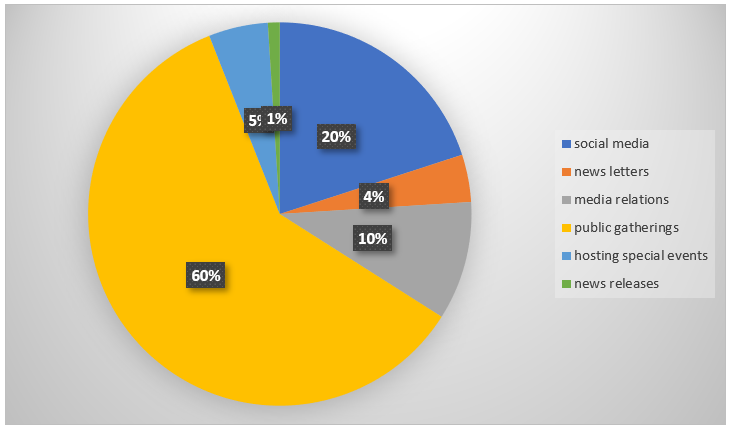
As shown in Figure 1, public gatherings are the commonly used tool to enhance PR practice. Different entities in the political atmosphere prefer the public gathering and social media to foster their political agenda and relevant public policies since it has a greater outreach and helps create greater awareness to the public. Mass gathering events drive citizen participation as opposed to newsletters that may fail to reach the targeted audience.
Figure 2: Number PR representatives in the organization
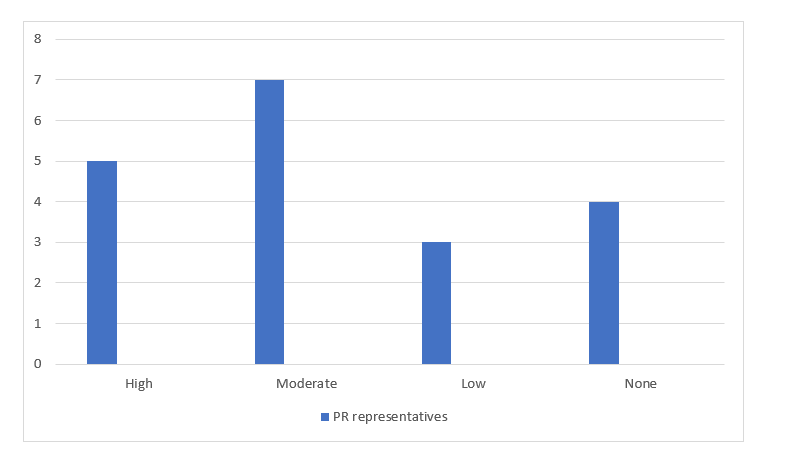
Figure 2 indicates that the majority of public entities have a moderate level of PR representativeness. The findings reveal that the government and other political actors are continuously realizing the impact of PR in their activities, and thus the increasing number of PR professionals in the political world. Thus, it implies that PR professionals are being employed in different departments to maintain beneficial reputation and relationships with the public while ensuring purposeful communication and action.
Figure 3: Impact of PPR
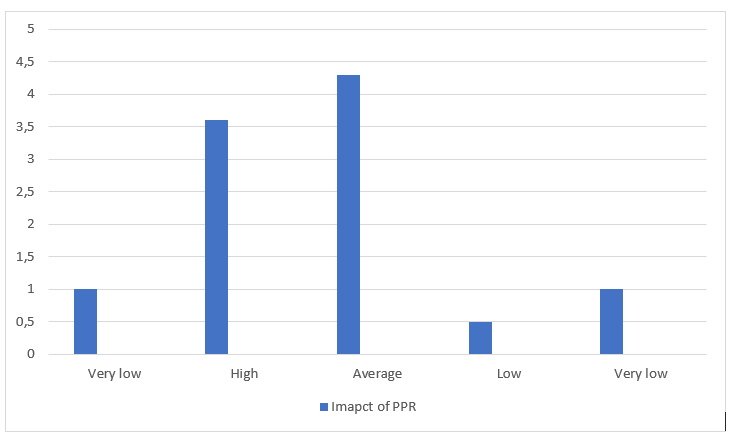
As shown in figure 3, the participants indicated PPR has an average impact on the stakeholders such as enabling politicians to gain much-needed exposure and can help to dismantle a political crisis. This finding implies that best PR practice is still needed to achieve a high impact of the different PPR tools used by various governments. In democratic societies, PPR is enhanced by media which help to influence the association between citizens and different government ministries or departments.
Figure 4:Challenges to effective PR practice
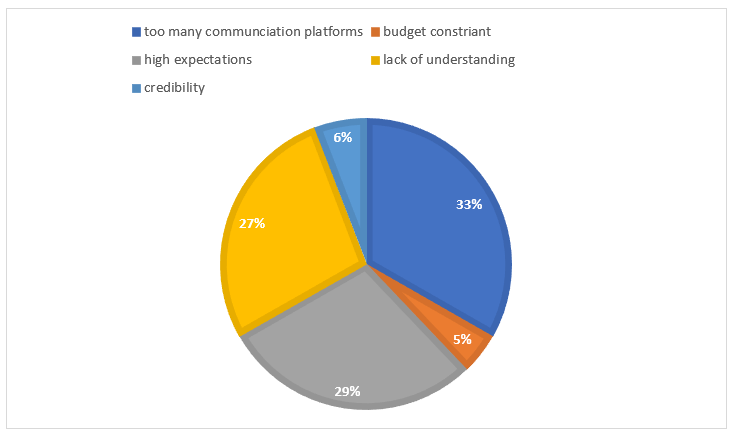
Figure 4 indicate that the credibility of the information displayed to the public challenges effective PR practice as the media is being by the modern political landscape to spread propaganda. However, high expectations from the leaders can cause misunderstanding and the information conveyed to the public can be detrimental to the government. Failure to ensure that the information is credible can damage the reputation of government institutions and different political actors. The risk of reputation is a major consideration when examining the challenges toward achieving effective PR practice in politics.
2. Qualitative results
The findings from the qualitative research were analyzed using a thematic approach and they are represented in different themes including PR in government, factors that influence PPR and communication strategies.
3. PR in government
PR is useful in changing the perceptions of citizens towards the government by creating familiar relations among the concerned stakeholders. The interviewee stated that“ governments use PR to spread information and create awareness about policies or schemes that can benefit the public“. Different platforms such as camp, calls, posters, SMS and email can help in the creation of strong and positive bonding between the public and the government. One of the interviewees further stated that “ PR should be centralized, and the local governments' should restrain from political affairs because they are mandated to promote the democracy of a nation and not to advance a political party's policy.” To enhance engagement with individuals or political parties, social media can be used to create conversation and dialogue. This statement was conferment by the respondent who stated that the “media and politicians gain profit from their interdependence in the efforts to spread the influence of PR”. However, most political public relations units are not properly established within the government sections.
4. Factors that influence PPR
Major factors that influence PR in politics include a platform of communication, finance, negligence of PR officers, public perceptions and political conditions. The respondent indicated that “people negative thoughts and attitudes regarding their governments, and this is influenced by fake news and propaganda spread in different media platforms”. Additionally, the findings reveal that the practice of PPR is concerned with the monitoring of electronic and print media, writing and editing various articles and publications, and press reviews. The interviewee argued that “some of the practices that were found to be influenced or affected by several factors include customer feedback review, addressing complaints of the customers, and conducting customer satisfaction surveys”. PR officers foster advocacy and publicity of policy issues within the government and organize public relations departmental events were also infected. The fourth respondent argued that “the media, both digital and print, are tasked with disseminating information and thus, act as mediators between the facets of civil societies and the government or state, remains critical”. Another interviewee stated that “the government is composed of various aspects of the society, and all facets of the government are related to one another, and they rely upon public relations for proper operations and functioning”. In modern governments and political parties, activities of PR are a mixture of propaganda and marketing
5. Communication strategies to enhance PR
Political actors share live broadcasts, press statements and memorandums on platforms such as Facebook and YouTube directly with audiences. As stated by the interviewee, “The activity scale of promoting good public relations is varied based on the nature and size of interested parties, the methods, strategy, and philosophy will be similar regardless of the influence of public relations program on international apprehension”. PR officials communicate political agendas mainly through public gatherings and social media whereby they have higher opportunities to interact with a large base of the targeted audience.
Political communication strategies take into consideration financial resources, agenda-setting, plan, target groups, media work and credibility. The interviewee stated that “PPR addresses the concepts associated with judicial bodies, government organizations, parties, campaigns and political candidates involved in the processes to achieve specific strategic objectives such as support for policy initiatives and election process”. Traditional perspectives related to public relations consider relationship management and image maintenance tactics within non-profit and corporate sectors. Another respondent revealed that, “different tactics for news management are used to influence public opinion and create a favorable public image in PPR”. Communication is an important activity that explains official political plans to citizens.
4. DISCUSSIONS AND CONCLUSIONS
The findings of the current study reveal that a low level of qualified staff, inadequate financial support, and inadequate equipment have a negative impact on the ability to ensure best PR practices by the government. Also, the practice is challenged by the lack of inadequacy of the national communication policy framework and poor apprehension of the roles of public relations officers. The current findings are in line with previous literature whereby Somerville and Ramsey (2013) argued that public servants operate in environments that are characterized by new approaches and skillsets, ambiguity, complexity, uncertainty and volatility. However, Ihlen and Fredriksson (2018) argued that political actors can face difficulties to gain a reputation for truthful and reliable communication based on issues such as alternative facts and fake news. Government actors need key competencies such as data analytical skills and stakeholder engagement to develop a good reputation in politics. Consequently, to curb these limitations different strategies can be adopted, which include providing enough office space for better working conditions; the staff should also be trained frequently to enable them to acquire the necessary skills for professionalizing their public relations practice. The sectors of the government should also be provided with adequate and timely funding to enable its efficient functioning.
The results demonstrate that given the advent of various technologies many liberal democracies continue to use social media networks in enhancing a participatory and transparent government. The present study confirms previous research by Béland (2017); Johnston and Sheehan (2020) who stated that the PR team is used to aid political messaging given the professionalism and consolidation of agencies, and the primary contribution of PR in politics include awareness, education and persuasion. Social media, events or mass placement efforts help to build awareness. The expected outcome is establishing, building and maintaining beneficial relationships and reputations in the political sphere (Strömbäck & Esser, 2017). All democracies have a political opposition interested in freedom of information and thus, seeks to expose administrative or political wrongdoing. The media pays attention to information that can reveal a scandal, incompetence or improper behavior.
The analysis indicates that public expectations about the government and politicians are influenced by an exponential increase in data and extreme connectivity that can contribute to greater demand for responsiveness, participation and transparency. However, Johnston and Sheehan (2020) had previously argued that PPR in the 21st century necessitate the relevant actors to focus on measuring communication impact, response approaches to listening, behavioral insights associated with social and digital media and finally, professionalism. Consequently, effective government communication and reputation management depend on the application of trust-building practices, distribution of speakers’ rights, resting on values that characterize conversation such as cooperation and the process should be value-led. PPR does not only consider communication but should involve different stakeholders such as party donors, think tanks and lobby groups.
6. Conclusion
Access to information is important in terms of a democratic government since it will provide room for citizens of a particular nation to make responsible and informed decisions or choices rather than making their choices or decisions out of misinformation and ignorance. PPR is mandated to develop a two-way communication strategy to effectively solve conflicts by seeking the common ground of mutual interests and to set up understanding and goodwill based on full information, knowledge, and truth. This clearly indicates the essentiality of public relations within the government and how it should be considered majorly in terms of recognition, positioning, staffing, and allocation of the budget.
Author: Christos Kreouzis
5. BIBLIOGRAPHY AND WEB RESOURCES
Dan, V., Ihlen, Ø., & Raknes, K. (2019). Political public relations and strategic framing: Underlying mechanisms, success factors, and impact. In Political public relations (pp. 146-164). Routledge.
De Vaus, D. (2016). Survey research. Research Methods for Postgraduates, 202-213.
Farooq, M. B., & De Villiers, C. (2017). Telephonic qualitative research interviews: When to consider them and how to do them. Meditari Accountancy Research.
Heath, R. L., & Waymer, D. (2011). Corporate issues management and political public relations. Political Public Relations: Principles and Applications, 138-156.
Ihlen, Ø., & Fredriksson, M. (Eds.). (2018). Public relations and social theory: Key figures, concepts and developments. Routledge.
Johnston, J., & Sheehan, M. (Eds.). (2020). Public relations: Theory and practice. Rutledge.
Kantola, A. (2016). Cleaning rotten politics, selling exclusive liaisons: Public relations consultants as storytelling professionals between markets and politics. Public Relations Inquiry, 5(1), 33-52.
Kiousis, S. & Strömbäck, J. (2014). Political public relations. In Political Communication (pp.249-266). Mouton de Gruyter.
Kiousis, S., & Strömbäck, J. (2011). Political public relations research in the future. Political Public Relations: Principles and Applications, 314-323.
Kiousis, S., & Strömbäck, J. (2014). 13 Political public relations. Political Communication, 18, 249.
Krishna, A., Connaughton, S. L., & Linabary, J. R. (2020). Citizens’ political public relations: Unpacking choices, and emergent and deliberate strategies in building trust and relations among groups in conflict. Public Relations Review, 46(1), 101853.
Lieber, P. S., & Golan, G. J. (2011). Political public relations, news management, and agenda indexing. Political public relations: Principles and Applications, 54-74.
Lilleker, D. G., & Jackson, N. (2011). Political public relations and political marketing. Political Public relations: Principles and Applications, 157-176.
Morse, J. M. (2016). Mixed method design: Principles and procedures (Vol. 4). Routledge.
Mukherjee, A., & Kamarulzaman, N. H. (2016). Mixed method research: A concept. In Mixed Methods Research for Improved Scientific Study (pp. 39-64). IGI Global. Béland, D. (2017). Identity, politics, and public policy. Critical Policy Studies, 11(1), 1-18.
Sanders, K. (2011). Political public relations and government communication. Political public relations: Principles and Applications, 254-273.
Sanders, K. (2019). Government communication and political public relations. In Political Public Relations (pp. 165-186). Routledge.
Somerville, I., & Ramsey, P. (2013). Public relations and politics. In The Public Relations Handbook (pp. 54-75). Rutledge.
Strömbäck, J., & Esser, F. (2017). Political public relations and mediatization: The strategies of news management. In How Political Actors Use The Media (pp. 63-83). Palgrave Macmillan, Cham.
Tedesco, J. C. (2011). Political public relations and agenda building. Political Public Relations: Principles and Applications, 75-94.
